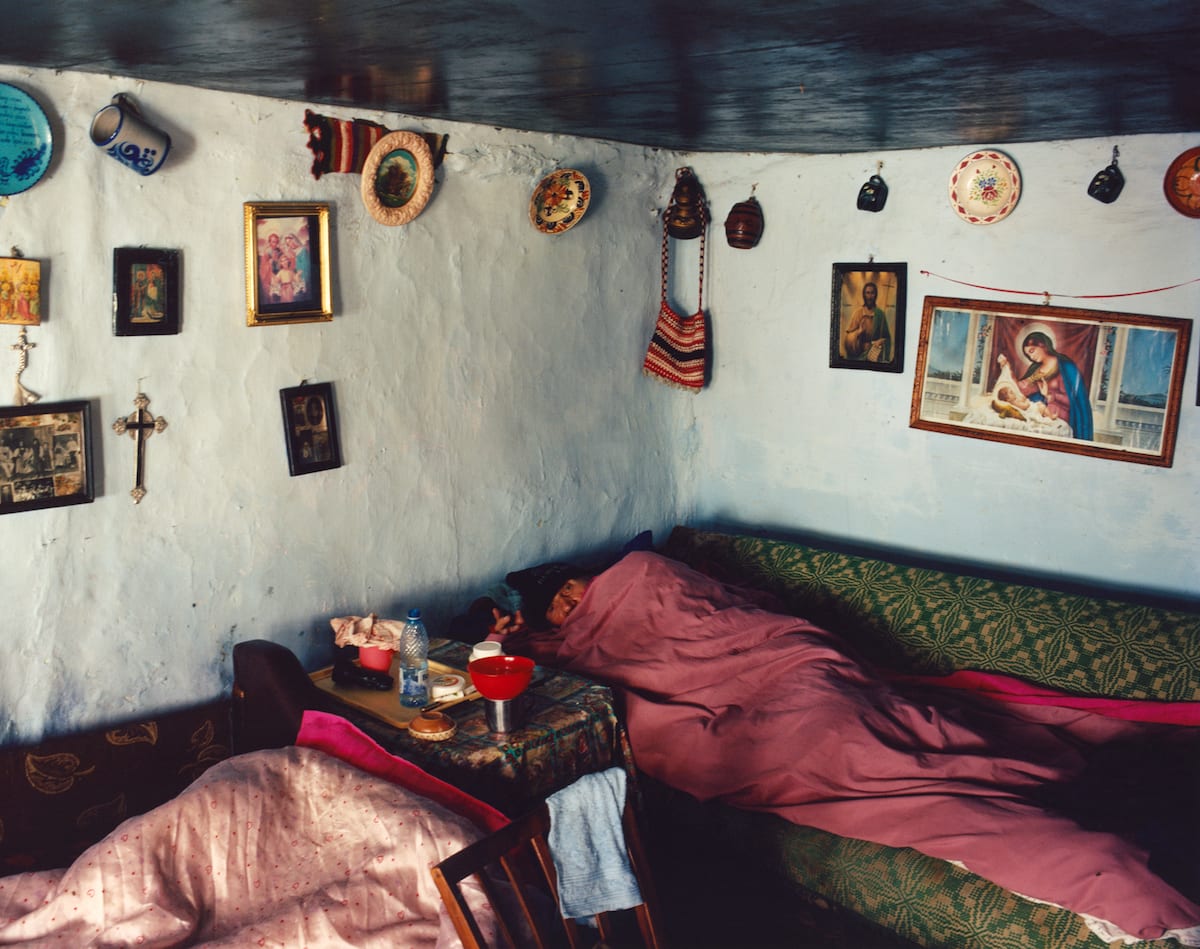A Short Pleasurable Journey, Part 2 invites us to experience a little-known Romanian commune through Hawkesworth’s eyes
Jamie Hawkesworth is wandering down a deserted road when he encounters a woman standing in front of her house. “She invited us in,” he recounts, “we enter a dark room and there was a man lying in bed”. Hawkesworth was momentarily shocked. “He waved at us – I thought ‘bloody hell’ and asked to take his portrait.” The man agreed and Hawkesworth set about taking the photograph. “His wife was telling us about her life while I was shooting; it is amazing that those kinds of exchanges can happen like that.”
The resulting image captures the intimacy of the scene. The framing draws us in; it is as if we are standing there too. And that was Hawkesworth’s intention. “I want to show that normal, everyday things can become, or hopefully feel, monumental,” he explains. The image is one of 86 photographs, and a film, which comprise Hawkesworth’s exhibition A Short Pleasurable Journey, Part 2 that went on show at 1–7 Aylesbury Street, London, 16 May 2019. The work developed over three weeks in July 2018 as Hawkesworth explored the commune of Floresti in Romania.
The photographer found himself in Floresti by chance. He was planning a short film in England and searching for an orchestra to produce the score. “I contacted the London Symphony School Orchestra and the conductor invited me to accompany them on a tour across Romania,” he explains. “We ended up in Floresti. I loved the place so much that I stayed.” Hawkesworth has travelled extensively; his professional and personal work has taken him around the world – from Preston to Antarctica, India to Louisiana. But, there was something about Floresti that captured his attention. “The place inspired me to be curious, which is the hardest thing to do,” he reflects. “And, I stayed curious – every time I went around another corner there was something else that made me want to carry on.”
Hawkesworth awoke each morning at sunrise and set off with no predetermined plan. The routine echoed the nature of his practice at the very start of his career. The photographer would embark on long, aimless walks to take pictures; on the weekend, he would pick a place by whim and catch the train there to explore. “I made a blog called Jaunt,” he says. “It was a very strange blog, but Jaunt in the dictionary means a ‘short, pleasurable journey’.” In the text that accompanies the exhibition, Hawkesworth expresses the importance of this creative approach. “Being open to chance felt like an education,” he explains. “[…] The constant rhythm of creative exchange gave me a sense of purpose and faith.”
Last summer, ahead of his exhibition A blue painted fence, which encompassed drawings and photography, Hawkesworth began writing down his feelings about the medium. His time in Floresti allowed him to inhabit these reflections: “When I ended up in Romania it felt like I was living those words.” However, this exhibition is more directly tied to A Short Pleasurable Journey: 51 Photographs, which went on show at Red Hook Labs, New York, back in 2016. Featuring work shot around the world, together, the images conveyed the sense of journey that underlies Hawkesworth’s practice. “It was this idea of going from Russia to Japan to Antarctica,” he explains. “How one photograph leads to another, and then to another – you really build a sense of rhythm in your work and your way of seeing.”
A Short Pleasurable Journey, Part 2 takes this idea further, centring on a journey through a single place. Hawkesworth’s aim: to create a show imbued with movement and discovery; to translate Floresti, and his experience of it, into the confines of the gallery space. “I wanted to give a sense of me exploring: you don’t just have these one-off, standalone images, but you see every step along the way,” he says. “It goes deeper and deeper into that momentum.”
The show sounds rhythmic, comprising colour and black-and-white images spanning a range of sizes. The photographs themselves should provoke a visceral response. They are not laden with meaning but exist to communicate the enchantment that Hawkesworth felt. “There were these wildflowers,” he remembers. “There were so many, and they were so close together, it really was like a wave of colour. I tried to mirror that experience. It is simple, but I like to think it is still effective despite being so simple.”
The exhibited film encapsulates this straightforward, yet evocative, approach. “I was looking out of the window and I saw this sixteen-year-old kid helping his Dad collect all of the grass in their barn,” says Hawkesworth. “The footage just follows this unfolding. It is an isolated moment within the trip, which somehow became extremely relevant.” The film takes us full circle. “I love the energy of it compared to the energy of the man in bed,” he continues. “It is sort of two ends of this little universe.”


